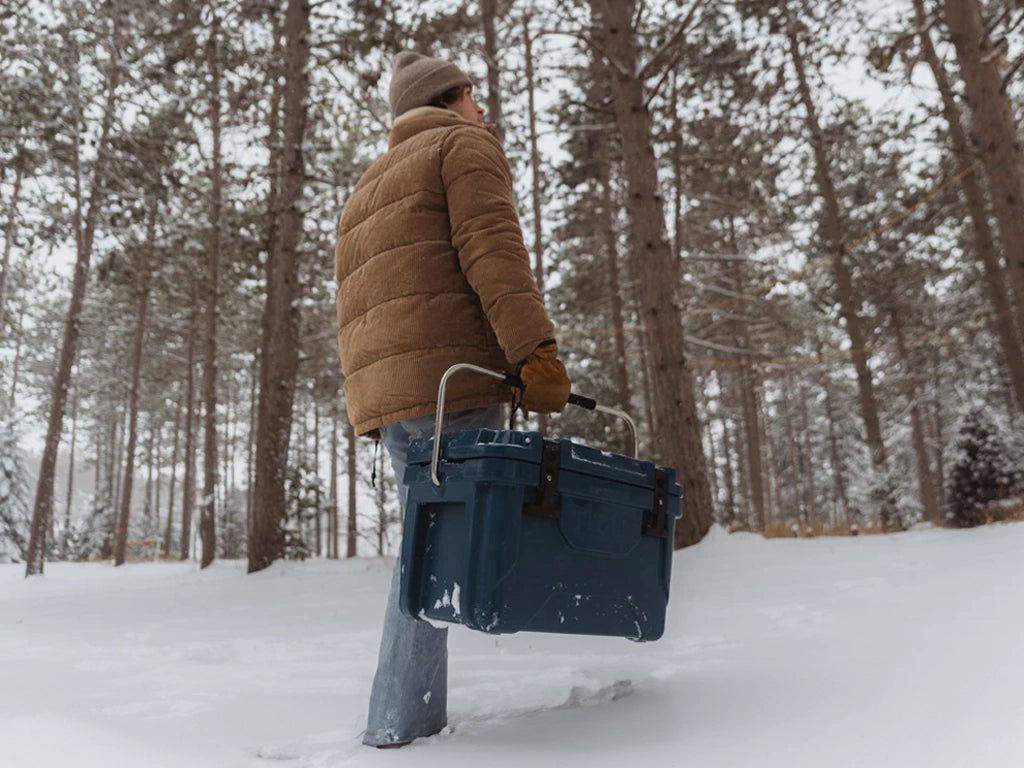Insulated Coolers are Great for Keeping Food Hot During Outdoor Winter Activities
They prevent beverages from freezing and protect gear too
With a few tips of the trade, the insulated cooler you depend on to keep food and drinks cold during the warmer months of the year can be just as important for outdoor winter activity. In fact, the insulation that creates a cold climate in the summer can be just as effective at creating a warm one in the winter.
For winter use, instead of adding ice to keep cooler contents cold, you’ll need to add heat to keep food warm. Remember that keeping the cooler hot is important as food that cools down provides a perfect breeding ground for bacteria. To avoid this and to enjoy a piping hot home cooked dinner at your campsite that night, here are some steps you can take:
As you’re preparing your cooler:
- Use a higher quality cooler that has thicker insulation capable of retaining heat. Check out the ice claims on the cooler. If the claims indicates multiple day ice retention, the cooler can also be used to keep foods warm longer.
- Start off with a warm cooler that’s been stored inside at least a day before your trip.
- Preheat your cooler by filling it with warm tap water and letting it sit for 30 minutes to 2 hours. Then, discard the water, dry your cooler and fill it with your warm food. DO NOT put boiling water in the cooler as it can warp the inside of the cooler or melt the insulation.
- Line your cooler with aluminum foil to add an extra layer of insulation.
- Place a towel or cloth at the bottom of the cooler to insulate your food and protect the cooler from heat damage.
- Encircle your food with insulated water bottles filled with boiling water. Replenish the hot water in the bottles with boiling water whenever possible throughout your trip.
- Keep food as hot as possible until you are ready to add it to the cooler.
- Wrap food in paper or regular towels to keep it warmer and prevent heated containers from damaging the sides and bottom of the cooler.
- Fill air spaces in the cooler with towels, cardboard or crumpled newspaper to add more insulation and prevent heat from escaping.
When using your cooler outside:
- Minimize the amount of times you open the cooler so it retains the heat longer.
- Keep your cooler firmly closed.
- Keep the cooler covered with an insulated or other heavy blanket and, in general, avoid as much direct exposure to cold temperatures as possible.
Use Your Cooler to Keep Beverages from Freezing
Another super function for your insulated cooler in the winter is to prevent beverages from freezing and especially, to ensure that beer or soda cans don’t explode from expansion caused by freezing liquids. To keep drinks from freezing in your cooler make sure that they aren’t completely covered in ice. Then, use layers. Just as layers are the secret to keeping your body at the right temperature, they’re also the way to keep your drinks from freezing in a cooler. You can wrap your drinks in insulated layers and pack them carefully in the cooler.
Featuring the Titan by Arctic Zone™ 20Q High Performance Hard Cooler.
Keep Clothing and Gear Dry
Finally, insulated coolers are ideal for storing and keeping your outdoor gear dry when doing sports such as snowmobiling or skiing. We highly recommend backpack coolers for a hands-free option. They can hold an extra set of dry clothes or an expensive camera or other gear that can be ruined if wet. For ice fishing, the cooler will keep bait from freezing.
Featuring the Titan by Arctic Zone™ 24 Can Backpack Cooler and Titan by Arctic Zone™ 30 Can Zipperless Hardbody® Cooler.
So, get that summer cooler out of storage and let it do dual-duty this winter to help you get the most enjoyment out of cold weather outdoor passions. And, after each use, remember to clean and dry your cooler and store it in a cool, dry place. This will ensure that your cooler will be around to help you enjoy leisure activities for many seasons to come.
Shop Coolers





